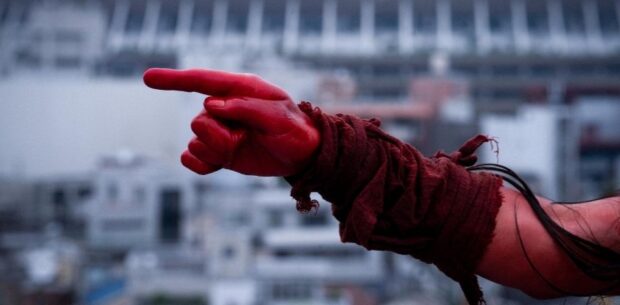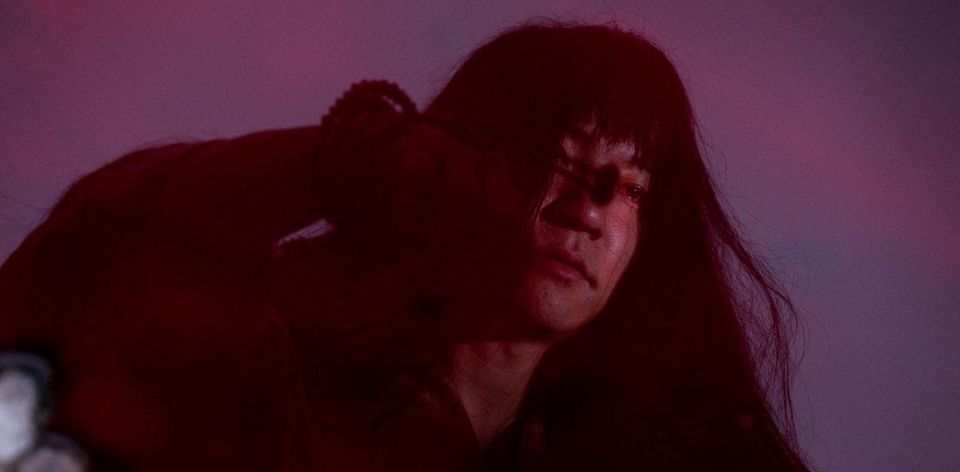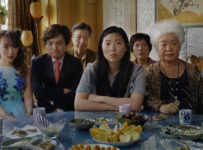If the world had not been actually plagued by a global pandemic, this would have dropped in Japanese cinemas on 24 July, the opening day of the Tokyo Olympics. If it had, some folks may have labelled it angrily seditious. In the absence of that large event, it stands as a shout of rebellion into the void of an indifferent world.
Following the audio-visual triumph of the short film Wolf’s Calling, filmmaker Toshiaki Toyoda (The Miracle of Crybaby Shottan) kicks it up a notch and delivers something that damn near slapped me in the face and shook me out of my complacency.
The loose plotting of THE DAY OF DESTRUCTION (破壊の日) picks up with a man entering a rural coal mine where a monster was found seven years earlier. Since then, a mysterious plague (timely!) and widespread mental illness have begun to spread. A young Shugendo reemerges to cleanse society of its ills.

Clocking in at just under an hour, and couched in symbolism and coded figures, this is the kind of film that attempts to grab a populace by its shirt collar and “exorcise a society” in the process. Well, some of it is not so coded, especially long scenes standing in front of Japan National Stadium while talking about the dangers of modernity.
At any other time and place, this may seem like an artfully constructed letter to the editor. Yet as Toyoda pummels each frame with images frighteningly close to our near future, it’s hard to be apathetic about what we’re viewing. A woman in a medical mask screams in the street. A yelling figure covered in blood pushes against the tide of mask-wearing people at Shibuya Crossing. “Tastes like disease to me,” says one figure. The stench of encroaching decay is almost tangible.
It might feel completely fatalistic at times, at least if it weren’t for the recurring figures of the red-clothed Kenichi and Natsuko, berobed in white. Their conversations are a bit like a post-punk version of an Ingmar Bergman film. “Maybe the exorcists themselves are the demons,” we’re offered. “Then we have no choice but to co-exist with the demons.” Heavy, man.
From a technical point of view, Toyoda’s film is an assault on the senses. Freewheeling from black and white to colour and back again, the music video aesthetic contains collisions of multiple eras, soundscapes and rapid fire imagery. It’s a modern fable of sorts where the choose-your-own-adventure options lead to death IRL and the collapse of civilisation as we know it.
Backed by Japanese death metal, the film ends with a finger unambiguously pointed at the audience. Yes, it’s all a bit shit right now, Toyoda seems to be saying, but it’s up to you to do something about it. Like Wolf’s Calling, we see a figure emerging onto a rooftop and looking across a city, only this time it’s bathed in red. To borrow a line from Ronald Heifetz, one needs to be able to stand on the balcony and observe yourself, always asking ‘what part of the mess am I?’
2020 | Japan | DIRECTOR: Toshiaki Toyoda| WRITER: Toshiaki Toyoda | CAST: Kiyohiko Shibukawa, MahiToThePeople, Issey Ogata, Itsuki Nagasawa, Shima Onishi, Yosuke Kubozuka, Ryuhei Matsuda| DISTRIBUTOR: JAPAN CUTS (US) | RUNNING TIME: 57 minutes | RELEASE DATE: 17-30 July 2020 (JAPAN CUTS)
Read more coverage of Japanese films from the silent era to festivals and other contemporary releases. Plus go beyond Japan with more film from Asia in Focus.







